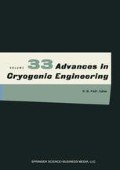Abstract
This paper reviews and summarizes the dielectric properties of liquid and gaseous helium and nitrogen, vacuum, and solid insulation materials for practical insulation design for superconducting coils. The influence of electrode geometry on breakdown voltage is discussed, and features that require special care are pointed out. Appropriate room-temperature high-voltage testing is considered. Finally, the paper examines the implications for coil insulation design of a new class of superconductors that can operate at temperatures approaching 77 K.
Research sponsored by the Office of Fusion Energy, U.S. Department of Energy, under contract DE-AC05-84OR21400 with Martin Marietta Energy Systems, Inc.
Access this chapter
Tax calculation will be finalised at checkout
Purchases are for personal use only
Preview
Unable to display preview. Download preview PDF.
References
H. Winkelnkemper et al., Breakdown of gases in uniform electric fields, Electra 52: 67 (1977).
J. D. Cobine, “Gaseous Conductors,” McGraw-Hill, New York (1941), pp. 143165.
E. Husain and R. S. Nema, Electric stress at breakdown in uniform field for air, nitrogen, and sulfur hexafluoride, in: “Proc. Fourth Intl. Symp. on Gaseous Dielectrics,” Pergamon, New York (1984), p. 168.
E. Gockenbach, The dielectric strength of some freons and their mixtures with nitrogen and sulphur hexafluoride, in: “Proc. First Intl. Symp. on Gaseous Dielectrics,” CONF-780301, Oak Ridge National Laboratory, Oak Ridge, Tennessee (1978), p. 355.
J. Gerhold, Dielectric breakdown of cryogenic gases and liquids, Cryogenics 19: 571 (1979).
M. J. Mulcahy et al., Designed experiments on high voltage vacuum breakdown, in: “Proc. Second Intl. Symp. on Insulation of High Voltages in Vacuum,” Massachusetts Institute of Technology, Cambridge (1966), p. 177.
B. Fallou et al., High voltage dielectric behavior of liquid and hypercritical helium, in “Low Temperatures and Electric Power,” Pergamon, New York (1970), p. 377 (in French).
K. N. Mathes, Dielectric properties of cryogenic liquids, IEEE Trans. on Elec. Ins. EI-2: 24 (1967).
P. H. Burnier, J. L. Moreau, and J. P. Lehmann, The dielectric strength of cryogenic fluids and solid insulators, in: “Advances in Cryogenic Engineering,” Vol. 15, Plenum Press, New York (1970), p. 76.
P. Chowdhuri, Some characteristics of dielectric materials at cryogenic temperatures for HVDC systems, IEEE Trans. on Elec. Ins. EI-16: 40 (1981).
M. M. Menon et al., Dielectric strength of liquid helium impregnated plastic tapes, in: “Annual Report-1975 Conf. on Electrical Insulation and Dielectric Phenomena,” National Academy of Sciences, Washington, DC (1978), p. 277.
G. Bogner, Cryopower transmission studies in Europe, Cryogenics 15: 79 (1975).
S. J. Rigby and B. M. Weedy, Liquid nitrogen-impregnated tape insulation for cryoresistive cable, IEEE Trans. on Elec. Ins. EI-10: 1 (1975).
I. Ischii and T. Noguchi, Surface flashover strength in super-critical helium, in: “Annual Report-1980 Conf. on Electrical Insulation and Dielectric Phenomena,” National Academy Press, Washington, DC (1980), p. 397.
R. Hawley, Solid insulators in vacuum: A review, Vacuum 18: 383 (1968).
J. Wankowicz, Flashover voltage of spacer insulators in a vacuum at 290–6K, Cryogenics 23: 482 (1983).
D. B. Hopkins, Design considerations and data for gas-insulated high voltage structures, in: “Proc. Sixth Symp. on Eng. Probs. of Fusion Research,” IEEE, New York (1976), p. 435.
A. Bouwers and P. G. Cath, The maximum electrical field strength for several simple electrode configurations, Philips Tech. Rev. 7: 270 (1941).
H. Ryan and C. A. Walley, Field auxiliary factors for simple electrode geometries, Proc. IEE 114: 1529 (1967).
M. Rabinowitz, Electrical breakdown in vacuum: new experimental and theoretical observations, Vacuum 15: 59 (1965).
J. Artbauer and J. Griac, Some factors preventing the attainment of intrinsic electric strength in polymeric insulations, IEEE Trans. on Elec. Ins. EI-5: 104 (1970).
A. Bulinski, J. Densley, and T. S. Sudarshan, The ageing of electrical insulation at cryogenic temperatures, IEEE Trans. on Elec. Ins. EI-15: 83 (1980).
J. Gerhold, Design criteria for high voltage leads for superconducting power systems, Cryogenics 24: 73 (1984).
F. Schauer, A capacitance-graded cryogenic high voltage bushing for vertical or horizontal mounting, Cryogenics 24: 90 (1984).
E. B. Forsyth and M. Meth, “Electrical insulation requirements for superconducting magnets used in a large system,” BNL 29968, Brookhaven National Laboratory, Upton, New York (1981).
M. J. Mulcahy et al., A review of insulation breakdown and switching in gas insulation, Insulation/Circuits 16: 55 (1970).
D. W. Bouldin et al., A current assessment of the potential of dielectric gas mixtures for industrial applications, in: “Proc. Fourth Intl. Symp. on Gaseous Dielectrics,” Pergamon, New York (1984), p. 204.
Author information
Authors and Affiliations
Editor information
Editors and Affiliations
Rights and permissions
Copyright information
© 1988 Springer Science+Business Media New York
About this chapter
Cite this chapter
Schwenterly, S.W. (1988). Design and Testing of Electrical Insulation for Superconducting Coils. In: Fast, R.W. (eds) Advances in Cryogenic Engineering. A Cryogenic Engineering Conference Publication, vol 33. Springer, Boston, MA. https://doi.org/10.1007/978-1-4613-9874-5_34
Download citation
DOI: https://doi.org/10.1007/978-1-4613-9874-5_34
Publisher Name: Springer, Boston, MA
Print ISBN: 978-1-4613-9876-9
Online ISBN: 978-1-4613-9874-5
eBook Packages: Springer Book Archive

